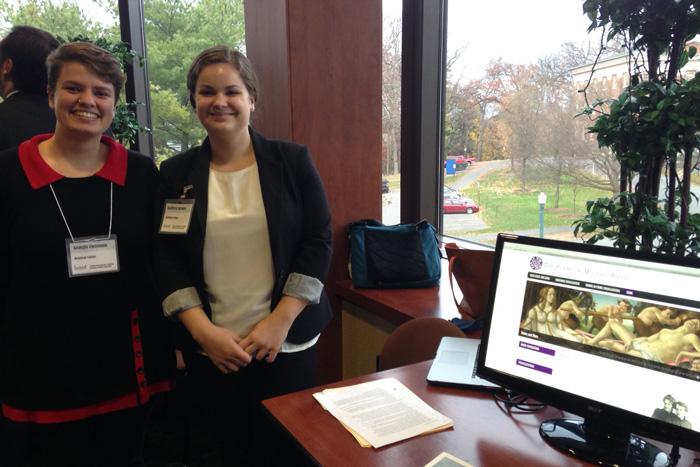Annotated Enigma

Over the summer, Georgia Christman '17 (left) and Kathleen Jarman '16 attended the Bucknell University Digital Scholarship Conference.
Student-faculty research brings 21st and 19th centuries together through enigmatic poet
Odds are, you’re not familiar with Michael Field. “He” (note the quotes) was a 19th-century British playwright and poet known for carousing with the likes of Oscar Wilde, Beatrix Potter and Rudyard Kipling—and then writing scathing things about all of them. But the social relationships Field built and inflamed are mere footnotes in a bigger story.
“Michael Field is actually two writers,” says Assistant Professor of English Sarah Kersh, who set out to digitize and annotate Sight and Song, Field’s 1892 volume of poems. It turns out that Michael Field, or “the Michael Fields,” as they’re often called, was in fact two women—Katherine Bradley and Edith Cooper—who were aunt and niece, lovers and later spouses who called each other Michael and Field and other male variations on the name.
“Field’s audience was incredibly highly educated, in terms of Greek and Roman mythology, in art history and in early Christian history,” Kersh says, adding that a collaborative digital humanities project made a lot of sense to parse such a collaborative figure. “[Field’s work is] fascinating, but it’s less accessible to students than it could be, which is why I needed a text made by students for students.”
Enter Sai Grandhi ’17 (mathematics, computer science), Kathleen Jarman ’16 (English) and Georgia Christman ’17 (English). Also integral were Todd Bryant, language technology specialist, and Ryan Burke, Web development specialist, who both did some heavy tech lifting via their posts in the Media Center. The group came together to build a Field website, create digital maps of the tropes the writers deployed and annotate the poems, guiding Field scholars through a thicket-like array of poetic and artistic references.
“When Professor Kersh brought up the idea of working together over the summer on LGBTQ Victorian poets, I was excited to spend a summer doing work I was interested in with an engaging professor,” says Christman, who, along with Jarman, compiled the background research and wrote the majority of the website’s annotations. “I hadn’t done work to this scale or with the digital aspects before.”
Operating under a Dana Research Assistantship grant, and under the supervision of Bryant, Grandhi used Drupal, PHP and JavaScript to develop the module that allows users to make annotations on the website, a focal point of the project.
“I was like, we can do it on paper, but I also want students to be excited about it,” Kersh says of the project, funded by a digital humanities grant from the Andrew W. Mellon Foundation that has helped Dickinson establish a leading role in the field over the last several years. “So Sai custom built the entire site and the annotation program.” What makes Sight and Song so right for this project—one that marries literature with technology—is that it’s ekphrastic poetry, meaning it’s written about specific works of visual art. “Sight and Song verses needed to be carefully paired with their corresponding paintings, which were not included in the original volume of the text,” says Kersh.
Michael Field’s work and persona represent a perfect storm of Kersh’s abiding interests—which include feminist and queer theory, poetics and the visual arts, 19th-century British and American literature and digital humanities—and they also provided her students with an intensive exercise, both academic and technical, in digital scholarship.
“I found the poets to be interesting and frustrating in equal measure, and the added challenge of working with the digital aspect made the project more enjoyable and opened up new pathways to seeing these works,” Christman says. “Certainly, I became personally invested in trying to understand their poems and lives, but I also discovered an academic interest in the time period and the ideas that came with it.”
Learn more
- The Poems of Michael Field (Digitized and Annotated)
- Department of English
- Department of Computer Science
- Dana Research Assistantship
- Latest News
Published February 29, 2016